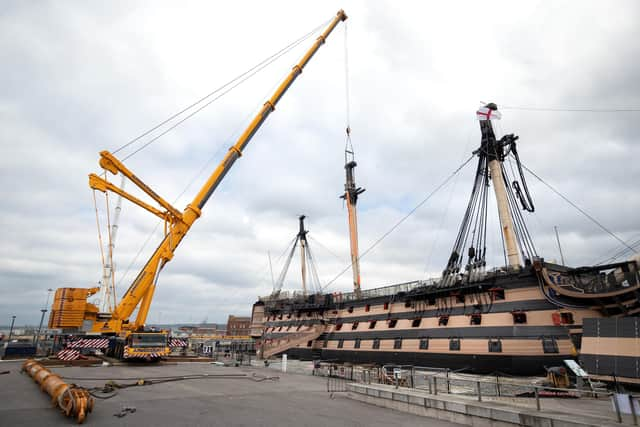Portsmouth's HMS Victory has mast removed as essential conservation work takes place
and live on Freeview channel 276
Essential conservation work is set to be carried out at Portsmouth Historic Dockyard, following a three-day operation to lift the 26 tonne mast structure ‘at a snail’s pace’ through the ship’s four decks from its anchor point in the orlop deck.
The original masts used for HMS Victory were wooden but a survey in 1893 found they were rotten and they were replaced with wrought-iron masts from the decommissioned HMS Shah.
Advertisement
Hide AdAdvertisement
Hide AdAndrew Baines, HMS Victory project director at the National Museum of the Royal Navy, said that the three lower masts, made in Portsmouth, were important artefacts and are believed to be the only surviving 19th century iron masts still in use.


He said: ‘Removing the lower mainmast has been an incredibly complex project.
‘Add in HMS Victory’s iconic status, her age and our desire to keep her open to visitors as much as possible, and we have been faced with some unenviable engineering challenges.
‘We have conducted ultrasonic thickness testing on the mast to understand its strength.
Advertisement
Hide AdAdvertisement
Hide Ad‘Structural analysis has calculated the stresses in the mast from the lift and allowed us to develop a method to keep them within allowable, safe levels.
‘We then needed a clear three-day window for both the 500 and 200 tonnes cranes to manoeuvre the mast from the ship, hoist it aloft 42 metres, and then place it safely alongside where we can analyse it further and agree on the next steps.’
The work is part of a 20 year conservation project on the warship.
HMS Victory, best known as Nelson’s flagship at the Battle of Trafalgar in 1805, is one of the oldest surviving examples of a wrought iron mast in the Royal Navy.
Advertisement
Hide AdAdvertisement
Hide AdMr Baines added that it was imperative for this work to be carried out sooner rather than later.
He said: ‘We know how strongly our visitors feel about Victory being without masts, but it is essential that we are able to complete this next stage of conservation, so she can remain open for the next 250 years.’
A message from the Editor, Mark Waldron
You can subscribe here for unlimited access to our online coverage, including Pompey, for 27p a day.
Comment Guidelines
National World encourages reader discussion on our stories. User feedback, insights and back-and-forth exchanges add a rich layer of context to reporting. Please review our Community Guidelines before commenting.
